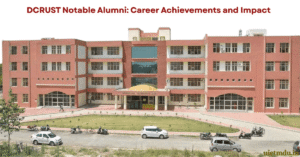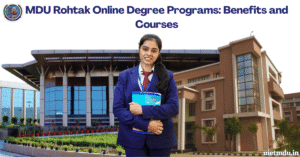Please find the GATE Syllabus 2023 details in this article. The GATE Exam Syllabus 2023 PDF is for a Computer Based Test that is jointly organized by the Indian Institute of Science (IISc) Bangalore and the seven Indian Institutes of Technology (IITs) in Bombay, Delhi, Guwahati, Kanpur, Kharagpur, Madras, and Roorkee. The National Coordination Board (NCB)-GATE, Department of Higher Education, the Ministry of Education (MoE), Government of India, is in responsibility of this exam.
On the official website, GATE Syllabus 2023 has been announced, along with other updates relating to the GATE exam dates and more. We have also updated the GATE Exam Syllabus information on this webpage for the students’ convenience. Students can return to this website for more information or specifics on the updated GATE Syllabus. The GATE Syllabus 2023 is important since it gives students an overview of the subjects and concepts included in the GATE examinations. It is important for students to pass the GATE Exams in 2023. It will decide their entrance and financial support to postgraduate programmes (Master’s and Doctoral) with the Ministry of Education (MoE) and other government scholarships/assistantships according to the admitting institute’s admission standards.
| Sr. No. | Subjects | Topics in Gate EE Syllabus 2023 |
|---|---|---|
| 1 | Electric Circuits | Network elements: ideal voltage and current sources, dependent sources, R, L, C, M elements; Network solution methods: KCL, KVL, Node and Mesh analysis; Network Theorems: Thevenin’s, Norton’s, Superposition and Maximum Power Transfer theorem; Transient response of dc and ac networks, sinusoidal steady-state analysis, resonance, two port networks, balanced three phase circuits, star-delta transformation, complex power and power factor in ac circuits. |
| 2. | Electrical and Electronic Measurements | Bridges and Potentiometers, Measurement of voltage, current, power, energy and power factor; Instrument transformers, Digital voltmeters and multimeters, Phase, Time and Frequency measurement; Oscilloscopes, Error analysis |
| 3. | Electromagnetic Fields | Coulomb’s Law, Electric Field Intensity, Electric Flux Density, Gauss’s Law, Divergence, Electric field and potential due to point, line, plane and spherical charge distributions, Effect of dielectric medium, Capacitance of simple configurations, Biot‐Savart’s law, Ampere’s law, Curl, Faraday’s law, Lorentz force, Inductance, Magnetomotive force, Reluctance, Magnetic circuits, Self and Mutual inductance of simple configurations. |
| 4. | Electrical Machines | Single-phase transformer: equivalent circuit, phasor diagram, open circuit and short circuit tests, regulation and efficiency; Three-phase transformers: connections, vector groups, parallel operation; Auto-transformer, Electromechanical energy conversion principles; DC machines: separately excited, series and shunt, motoring and generating mode of operation and their characteristics, speed control of dc motors; Three-phase induction machines: principle of operation, types, performance, torque-speed characteristics, no-load and blocked-rotor tests, equivalent circuit, starting and speed control; Operating principle of single-phase induction motors; Synchronous machines: cylindrical and salient pole machines, performance and characteristics, regulation and parallel operation of generators, starting of synchronous motors; Types of losses and efficiency calculations of electric machines |
| 5. | Engineering Mathematics | Linear Algebra Calculus Differential Equations Complex Variables Probability and Statistics |
| 6. | Power Systems | Basic concepts of electrical power generation, ac and dc transmission concepts, Models and performance of transmission lines and cables, Series and shunt compensation, Electric field distribution and insulators, Distribution systems, Per‐unit quantities, Bus admittance matrix, Gauss- Seidel and Newton-Raphson load flow methods, Voltage and Frequency control, Power factor correction, Symmetrical components, Symmetrical and unsymmetrical fault analysis, Principles of over‐current, differential, directional and distance protection; Circuit breakers, System stability concepts, Equal area criterion, Economic Load Dispatch (with and without considering transmission losses). |
| 7. | Power Electronics | Static V-I characteristics and firing/gating circuits for Thyristor, MOSFET, IGBT; DC to DC conversion: Buck, Boost and Buck-Boost Converters; Single and three-phase configuration of uncontrolled rectifiers; Voltage and Current commutated Thyristor based converters; Bidirectional ac to dc voltage source converters; Magnitude and Phase of line current harmonics for uncontrolled and thyristor based converters; Power factor and Distortion Factor of ac to dc converters; Single-phase and three-phase voltage and current source inverters, sinusoidal pulse width modulation. |
| 8. | Analog and Digital Electronics | Simple diode circuits: clipping, clamping, rectifiers; Amplifiers: biasing, equivalent circuit and frequency response; oscillators and feedback amplifiers; operational amplifiers: characteristics and applications; single stage active filters, Sallen Key, Butterworth, VCOs and timers, combinatorial and sequential logic circuits, multiplexers, de-multiplexers, Schmitt triggers, sample and hold circuits, A/D and D/A converters. |
| 9. | Signals and Systems | Representation of continuous and discrete time signals, shifting and scaling properties, linear time invariant and causal systems, Fourier series representation of continuous and discrete time periodic signals, sampling theorem, Applications of Fourier Transform for continuous and discrete-time signals, Laplace Transform and Z transform |
| 10. | Control Systems | Mathematical modeling and representation of systems, Feedback principle, transfer function, Block diagrams and Signal flow graphs, Transient and Steady‐state analysis of linear time-invariant systems, Stability analysis using Routh-Hurwitz and Nyquist criteria, Bode plots, Root loci, Lag, Lead and Lead‐Lag compensators; P, PI and PID controllers; State-space model, Solution of state equations of LTI systems, R.M.S. value, average value calculation for any general periodic waveform. |
GATE Exam 2023 Pattern for Electrical Engineering
| Sr. No | Specifics | Describes in detail |
|---|---|---|
| 1. | Number of Questions | Total 65 Questions |
| 2. | Type of Concept | There will be two types of questions: Multiple Choice Questions (MCQs) Numerical Answer Type (NAT) Questions |
| 3. | Elements | There will be three sections in the question paper: General aptitude Engineering Mathematics Electrical Engineering |
| 4. | Marking Pattern | For 1 Mark MCQs – ⅓ mark will be deducted for every wrong answer. For 2 Mark MCQs – ⅔ mark will be deducted for every wrong answer For unattempted questions, zero marks will be given There will be no negative marking for Numerical Answer Type (NAT) questions. |













